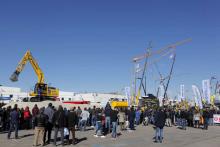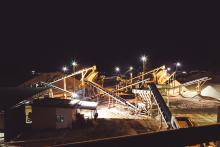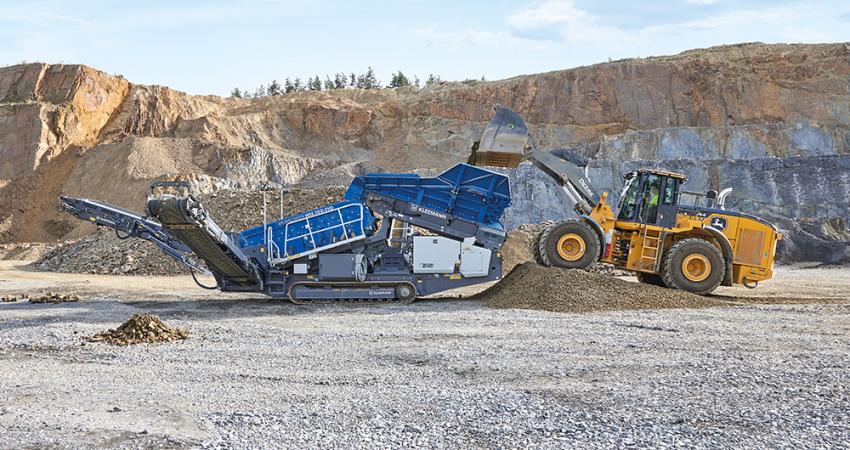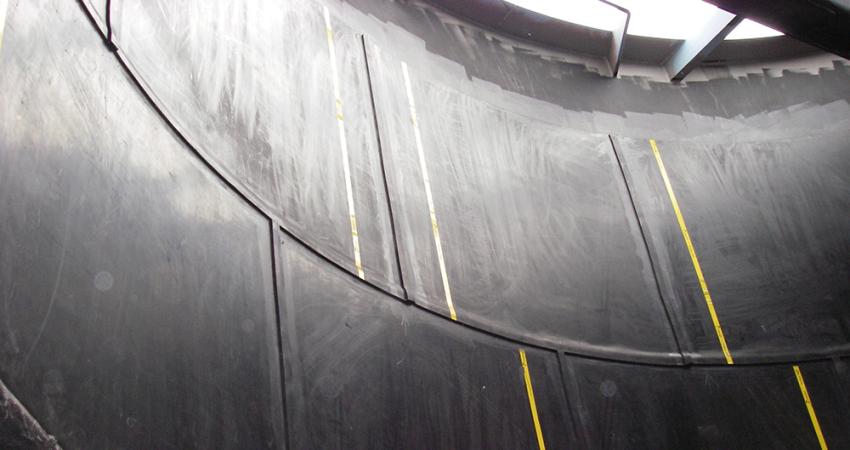
Demand for aggregates has continued to be robust in India during 2023. Industry analysts estimate 8-10% growth for the next 12-18 months, driven by new roads, highways, expressways and housing infrastructure works. The high demand for aggregates has swelled the demand for mineral-processing equipment along with extraction, loading and hauling machinery. This is partly due to the sheer volume of road construction. The National Highways Development Project, led by the Indian government, aims to expand the country’s current expressway network with an additional 18,637km of greenfield expressways by 2025. A four-lane greenfield national highways network of nearly 50,000km under the National Highway Development Project [Phase 6 & 7] is also planned.
Strong aggregate demand is also down to expanding Indian railway infrastructure. As well as the doubling and tripling of track capacities, preparations are underway to start the high-speed Ahmadabad- Mumbai rail project in Western India, which will require a vast quantity of virgin ballast materials. Granite, gabbro, aplite, dolerite, rhyolite, basalt, sandstone, limestone, granulite, gneiss, schist and marble are all in great demand across the Indian infrastructure construction industry.

Led by heightened infrastructure construction, the Indian construction-equipment industry registered an impressive growth of 26%, with sales of over 100,000 units during the 2022-2023 financial year. The mineral-processing segment notably contributed to this, with increased sales of screeners, jaw, cone, and impact crushers. Tracked excavators and backhoe loaders accounted for 90% of earthmoving equipment sales. The construction-equipment industry is expected to grow 15-20% in the 2023-2024 financial year. The buoyancy of India’s infrastructure construction sector is expected to continue well into 2024 and beyond, fuelling higher demand for equipment.
There are some concerns over the continuing export competitiveness of Indian construction equipment manufacturers. Dimitrov Krishnan, managing director of Volvo CE India, says: “Indian CE manufacturers have been exporting to over 100 countries, including advanced nations, but to fully harness capacity, a robust supply chain ecosystem is imperative.”
Sharing similar views, Anand Sunderasan, managing director of Ammann India, adds: “The current excess capacity in manufacturing remains underutilised. This is due to gaps in the logistics supply chain. Additionally, volatility in steel prices impacts profitability and export competitiveness.”
Led by large-scale activity in India’s quarry sector, excavator demand is likely to grow 15% in the 2023-2024 financial year, mostly due to the popularity of 20-tonne class machines. Analysts believe the scale of national infrastructure construction will also notably boost backhoe loader sales.
Jayakara Kalmadi. regional business head, North, at Tata Hitachi, Construction Machinery, India, says: “Demand for excavators from the quarry sector has continued for the 20-tonne class machines. Quarry owners find the 20-tonne class units more profitable as margins remain compressed owing to higher fuel costs. A similar trend can be seen in 30-tonne-plus class excavators for marble and granite mining.”
Kalmadi continues: “Led by the expansion of activities in quarry clusters of Jhansi in Uttar Pradesh, Uttarakhand, Punjab, and Haryana, we are witnessing a gradual shift in demand for wheeled loaders from the 3-tonne class to the 5-tonne class using 1.2m³ buckets rather than 0.9m³ buckets. This reflects the current preference for processing higher volumes of aggregate in 250 and 350-tonne-per-hour crushing plants rather than the previously preferred 150-tonne-per-hour units.
“Demand for higher capacity wheeled loaders is also due to quarries' greater production of manufactured sand. We had been having some good enquiries from some of the crushing plant operators in North India for the hydrostatic wheeled loaders.”
According to Nischal Mehrotra, senior vice president of marketing for LiuGong India, the demand for 20-ton class excavators will continue to dominate the quarry segments. “However, for certain quarries having 250-300 tonnes-per-hour plants with higher productivity requirements and longer working duration of between 15-16 hours, there is now demand for bigger 26.5-tonne machines. We have been getting repeat orders for the bigger capacity excavators from some big quarry owners and even road contractors in North India.”
Mehrotra continues: “ Interestingly, some owners have also been interested in the below 5-ton class and above 3-tonne units. To cater to this, we have recently introduced for the Indian Market our 848, 4.5-tonne class wheeled loaders, with newer emission norm engines, targeting 200-250-tonne crushing and screening plants.”
Rahul Srivastava, industry solutions manager - Quarry & Aggregates (Asia Pacific) Caterpillar, says that depending on the quarry size, 20-23-tonne excavators, such as the Cat 320D3 GC, 320D3 and 323D3, are a popular Indian customer choice for face loading and crusher feeding. “For mid-sized quarries, 30-tonne excavators, such as the Cat 330 GC, are an efficient and productive choice. In large quarries, especially with limestone, the Cat 350, 374, and 395 large excavators provide high production levels and can work together with the Cat 770G, 772G and 777E trucks. The Cat 777E offers best-in-class productivity, increased fuel economy and torque, and a durable, low-cost-per-tonne option.
“For face loading, the Cat 986K and 988K large wheeled loaders move material efficiently and safely at a lower cost per tonne in quarries with good blasting fragmentation. Quarries can configure the Cat large wheeled loaders as aggregate handlers and a block-handling configuration is available for granite and marble quarries.”
To drive the excavator business in India, manufacturers offer machines with more versatility based on newer application needs. This is through attachments like crusher buckets, concrete cutting and shearing machines (demolition and recycling needs), and hydraulic hammers. Backhoe loader manufacturers have also begun introducing new machines with CVF IV electronic engines that deliver 8-12% fuel efficiency and a 15% reduction in maintenance costs.
Mini excavators are now emerging as popular machines for some Indian quarry operators, notes Manjunath Shankarappa, director of sales for India and SAARC (South Asian Association for Regional Cooperation) at Doosan Bobcat India. “Due to the higher initial costs of backhoe loaders and excavators, some medium- and small-size quarry owners are looking for mini excavators between 2, 3.5 and 5 tonnes that can work with breaker attachments. The machine is also a preference for demolition jobs.”
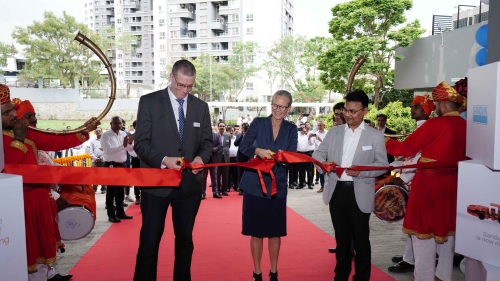
To meet the growing long-term projected demand for equipment from the Indian construction sector and reduce initial acquisition costs, original foreign equipment manufacturers (OEMs) are expanding their production capacities in India. This is through localised production. Major capacity expansions are also underway by Indian manufacturers as well.
Sandvik recently commissioned its second state-of-the-art plant in Pune, Maharashtra, Western India, to assemble its jumbo mining and tunnelling drill rigs. The company handed over the keys to two DT820 units to customers during the plant's inauguration.
By producing jumbo mining and tunnelling drill rigs in India, Sandvik will reduce contractors’ dependence on imports and increase the availability of these machines, helping cater for the increased number of national tunnelling projects. Moreover, the facility’s strategic location in Pune, a hub for engineering and manufacturing, enables closer collaboration with suppliers, customers, and industry experts. The production of mining and tunnelling jumbo drills at the new facility has already commenced, primarily focusing on the highly acclaimed DT820 model. The DT280 has become Sandvik’s flagship due to its popularity among Indian tunnel construction contractors.
The Sandvik jumbo drills have been deployed in numerous prestigious Indian tunnel infrastructure projects. Some notable examples of their successful implementation are the SevokRangpo Rail Project in Sikkim (Eastern India), Kuther Hydro Electric Project in Himachal, Kangra Bypass Road tunnel in Himachal Pradesh( North India). One of the most prestigious is the Rishikesh-Karnaprayag Rail Project, where the DT820 jumbo drills displayed superior capabilities.
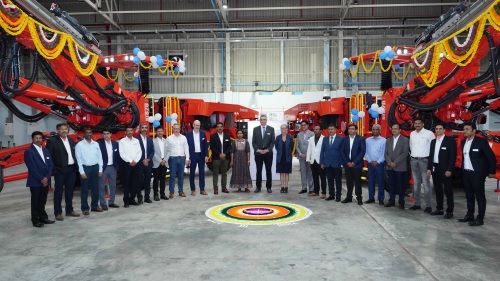
Manojit Haldar, managing director and president of Sandvik Mining and Rock Technology India, says the company is well-positioned to cater to its customers' dynamic and diverse project-application requirements. “Our advanced technology, superior equipment and especially unparalleled parts and service support make our offerings unbeatable. The high capital investment that Sandvik has injected into this new facility underlines our dedication and resoluteness to propel India’s tunnel infrastructure sector to new heights.”
Prabhat Mittal, vice president - Tunneling & Mechanical Cutting, Sandvik Mining and Rock Technology India, adds: “Our new facility will not only enable us to streamline our manufacturing processes but will also drastically reduce the delivery times of our jumbo drills to customers. This is bound to catapult the Sandvik brand into a stronger position in the tunnelling industry, an industy seeing a spate of ongoing and planned projects.”
Mittal told Aggregates Business that while the delivery time for jumbo drills from Sandvik’s European facility to India had been close to four to five months, including two months shipping time from Europe to an Indian port, the new production unit will allow Sandvik to offer far faster delivery and more efficient linked services.
Major global manufacturers' investment in India-based production and assembly facilities is also proving a good business-generation tool for the country’s parts supply businesses.
Manik Daware, director of Profive Engineering, says: “We are suppliers of fabricated components, conveyors parts and outriggers for tracked crushing plants to Wirtgen India. We also do the fabrication of rigid dump truck bodies for Hyva India. Very recently, at our Chakan plant in Pune, we have begun production of components for JCB UK and the Sandvik jumbo drill rigs being produced at the company’s new Pune India plant. Business has been quite good during 2022 and also in 2023.”
To meet the fabricated product standards for foreign and some Indian original equipment manufacturers (OEMs), Profive has acquired ISO 3834-2 welding certification. The company is also expanding its Chakan production capacity.
Another emerging trend is the popularity of alternative fuel-powered construction equipment and wider sustainability-enhancing production technologies. Nitin Gadkari, India’s Union Road Transport and Highways Minister, addressed a recent seminar attended by Aggregates Business focused on localisation, sustainability and usage of alternate fuels to bring down equipment-operation costs. Gadkari stressed the need to adopt sustainable technology and alternative fuels such as ethanol and methanol, which could reduce operational costs by 25 to 40%, boosting the construction industry's competitiveness and economic viability.
He urged cooperation, coordination, and communication among stakeholders in implementing India’s sustainability roadmap. “Manufacturers must develop cost-effective equipment, uphold worker's safety, and foster job creation.” Gadkari also underscored the Indian government's commitment to improving road infrastructure, coal mining, airports, and waterways. He said that making the best use of available resources and maintaining high-quality standards would also drive demand for Made in India equipment in international markets.
Jaideep Shekhar, managing director for Asia/EMEAR at Terex India, says that in line with Indian government directives, utilising waste material in road construction, particularly slag usage, is gaining acceptance as a scientific approach to reducing reliance on virgin aggregates. “Such practices have been successfully applied in projects like the Ludhiana Road construction in North India. Manufactured sand and electrification in the crushing and screening industry is widely embraced, and telematics and mobility solutions are improving productivity through better equipment usage tracking.”
Looking to deliver sustainability and lower operations costs, LiuGong India has aggressively promoted the sales of its electric 856E Max-EW six-tonne wheeled loaders for the Indian market. The machine was launched during bauma Conexpo India 2023.
LiuGong India’s Nischal Mehrotra says: “We have been working to prove the performance cost-competitiveness of the machines and have been able to sell two units so far. The third machine is under trial. We are targeting the loaders for the cement, power steel plants and even big-size crushing units beyond 350-tonnes-per-hour capacity.”

The users have found the loaders' performance highly cost-competitive as it costs them 3.3 units of electricity consumption compared to a claimed 17 litres/unit for a similar class wheeled loader. Furthermore, the machines, being simple, have negligible maintenance costs.”
Speaking about VE Commercial Vehicles’ approach to green technologies for its rigid dump trucks and other on-road vehicles, Vinod Aggarwal, the company’s managing director and CEO, says: “As a 15-year joint venture between Volvo Group and Eicher Motors, VE Commercial Vehicles (VECV) has a track record of bringing modern and sustainable transportation solutions to customers through the Eicher and Volvo brands in India. Today, our electric trucks and buses operate with progressive customers in specific applications.
“We have advanced plans for electric, hydrogen fuel cell, hydrogen ICE [internal combustion engine], bio blend and CNG [compressed natural gas] powered machines. As charging infrastructure improves and green energy becomes widely available in India, we forecast rapid adoption of our electric and clean technology vehicles by customers.”
Aggarwal stresses that sustainability is also about efficient asset utilisation. “All Eicher and Volvo trucks and buses, electric- or otherwise powered, are backed by a 100% connected ecosystem with AI-based diagnostics to further deliver on our promise of productivity and uptime for our customers. “As a leading commercial vehicle industry player, VECV is committed to driving decarbonisation and sustainability in India.”
Sunil Gupta, chief operating officer of Vedanta Aluminium, an Indian aluminium-producing major, says: “In addition to our offerings for the automotive sector, we are also one of the leading adopters of EV technology within India’s manufacturing landscape. We host India’s largest fleet of electric lithium-ion forklifts, with 44 units now deployed across our operations in Odisha ( Eastern India) and Chhattisgarh (Central India). We also aim to decarbonise 100% of our light motor vehicle fleet by 2030 and 75% of our mining fleet by 2035.”
Commenting on growing Indian quarry and crushing and screening contractor demand for greater machine uptime and performance via enhanced OEM equipment support, Ashutosh Chandwar, chief operating officer at Indian construction major Dineshchandra R. Agrawal Infracon (Dineshchandra), says: “We have strict internal targets of 85% availability for our crushing plants, excavators, backhoe loaders and wheeled loaders. A similar target is set for our ready-mix concrete equipment, shotcrete equipment, boom placers and concrete pumps. For our rigid dump trucks, it is as high as 95% availability required. We are only going for equipment brands that meet our set machinery availability needs with appropriate service agreements.”
Chandwar says that while Dineshchandra has a long history of purchasing Caterpillar excavators, the company also recently acquired Kobelco excavators due to the quality of the product support offered by the manufacturer’s Indian dealer. “It’s a similar case with Tata Motors, who provide timely product support services,” says Chandwar, noting that Dineshchandra recently acquired 15 Tata 2518 rigid dump trucks.

To ensure lower operating costs of its crushing and screening units, Dineshchandra has been going in for contract crushing. “When we need to produce 5 lakh tons of aggregates, we enter into contractual service agreements with crushing and screening OEMs. The OEMs operate and support the plants; we pay them per tonne. Sometimes, we outsource our plants to independent plant operators, where our responsibility remains only to make the boulder feed materials available.”
Chandwar says Dineshchandra recently entered into a service agreement with Terex India for one of its new wet-process sand-washing plants. “The plant was installed in one of our project sites six months ago. Based on the agreement, Terex will deliver us an output of 3 lakh tonnes from the plant along with operating and supporting the plant.”
Dineshchandra possesses two-stage Terex and Sandvik crushing and screening plants consisting of jaw crushers and vertical shaft impactors (VSI). The company also has cone crusher and VSI-based three-stage plants. Major infrastructure projects involving Dineshchandra include a 17km stretch of the Ahmadabad-Mumbai High-Speed Rail Project. It is also building a 35km stretch of the Delhi-Mumbai Expressway.
Another major Indian company, H.G. Infra Engineering (H.G. Infra), regularly opts for a contract-crushing approach. The business is delivering a major INR 5000 crore package to Ganga Expressway in the Northern India state of Uttar Pradesh. H.G. Infra has other major road development projects in three other Northern India states, Himachal Pradesh, Uttarakhand, Jammu & Kashmir.
Subhash Sharma, vice president of plant and machinery at H.G. Infra, says: “We have varied models of operating our crushing plants, some of which are based on outsourcing our crushing activities to reduce operating costs and ensure a steady aggregate supply. Based on service agreements, we hand over our plants for OEMs to run and give us an agreed tonnage throughput backed by an annual maintenance contract. We also outsource our plants to professional operating agencies to produce an agreed volume of material. On other occasions, we deploy and operate our crushers ourselves. However, this depends on the availability of boulder materials to crush.
“Outsourcing crushing is often viable due to the big size of our projects, where we usually require more than 500,000 tonnes of aggregates.”



